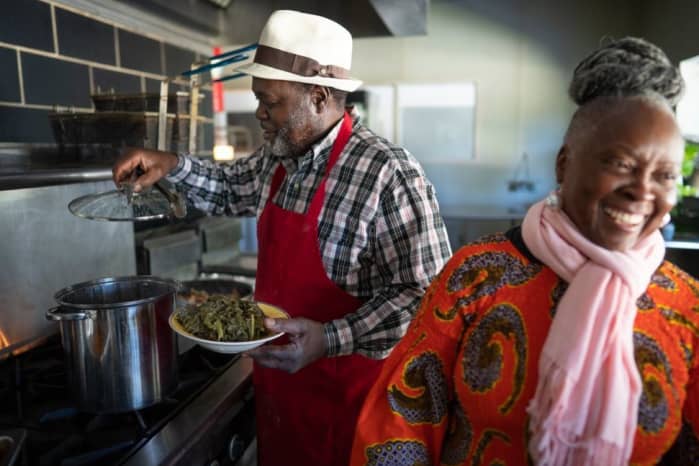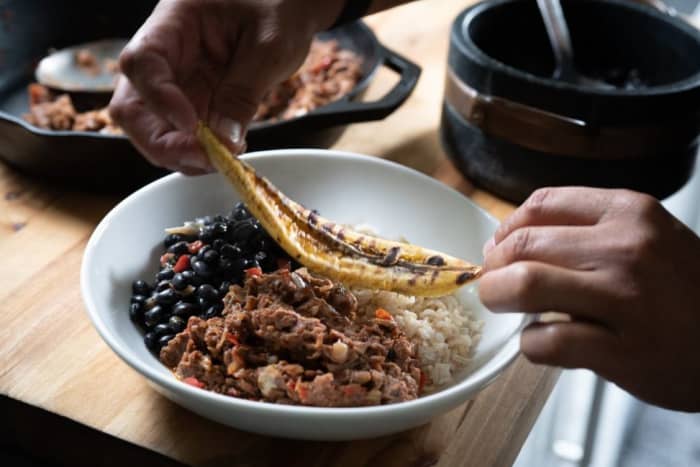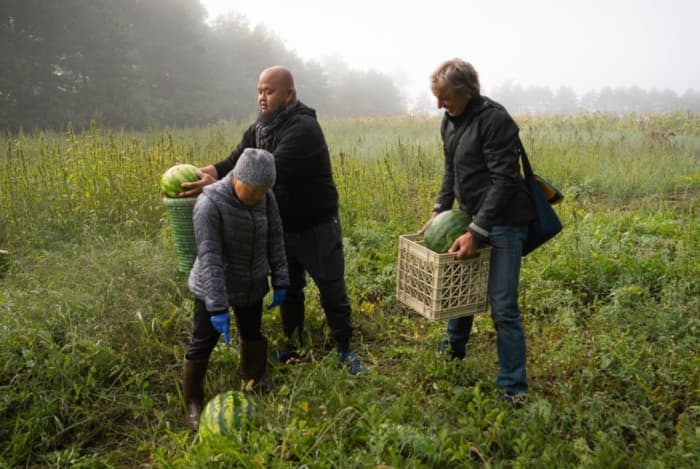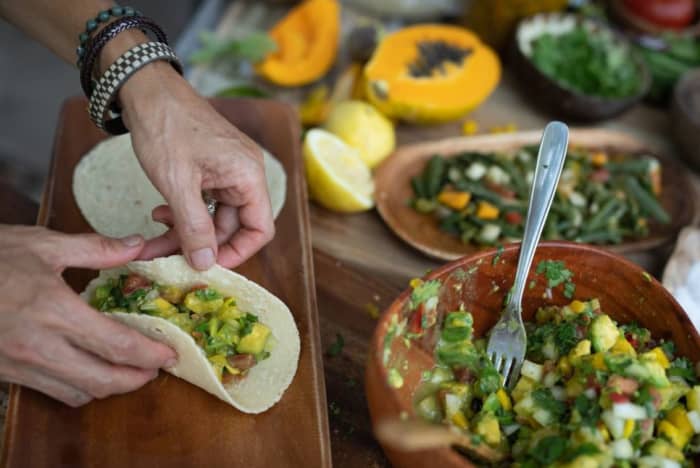This post was originally published on this site
There are a handful of spots in the world where lifestyles, and in all honesty, food choices alone, make for the highest rate of individuals who reach the age of 100 and beyond.
They’re known as “Blue Zones,” and for 20 years, National Geographic writer Dan Buettner has been studying the habits behind these populations’ longevity, often pulled up around their dinner tables. Why Blue Zones? Simply because the exploration into the mystery of longevity began with blue circles drawn on a map.
Buettner first looked closely at Okinawa, Japan; Sardinia, Italy; Ikaria, Greece; Nicoya, Costa Rica; and a Seventh Day Adventist community in Loma Linda, Calif. He found in these geographies the highest centenarian rate and the highest middle-age life expectancy than pretty much anywhere else in the world. Importantly, he turned his discoveries into a series of journalistic cookbooks, seminars and other resources so that the secrets might be shared.
This year, the best-selling Blue Zones Kitchen author has turned his attention fully to the U.S.
With “The Blue Zones American Kitchen: 100 Recipes to Live to 100,” Buettner aims to convince more American eaters that creating your own Blue Zone with mostly plant-forward suggestions is easier than ever. The shared recipes feature inexpensive and regularly available options in backyard gardens, major grocery stores and specialty food shops. Chapter titles cover dishes and techniques from Indigenous and Early American culture; African American; Latin American; Asian American; and a collection of regional and contemporary American recipes.
Read: Eating 400 calories a day from these foods could raise your dementia risk by over 20%
“ Women can add 10.7 years on average to their lifespan by eating the Blue Zone way, and men can add an average of 13 years. ”
Blue Zone residents experience generally a fifth the rate of heart disease, a sixth the rate of dementia, and a sixth the rate of certain cancers compared with Americans consuming our typical diets, which tend to include processed food and plenty of meat. The obesity and diabetes rates in each Blue Zone historically were under 5% although have been creeping up. The people in the studied areas, who are eating much the same way their ancestors did, live roughly a decade longer than average Americans and spend a fraction of what most of us do on healthcare.
While no food is technically off limits as to avoid the trappings of fad diets that just don’t work, Buettner says, he stressed in an interview with MarketWatch there are notable exclusions.
For one, sugar doesn’t figure much into Blue Zone diets, except occasionally as honey. In all, people within Blue Zones consume about seven teaspoons of sugar a day, about a third of the 22 or so teaspoons the average American takes in both by adding sugar from the canister and via processed foods. Prevalent beverages include water, teas of all kinds, black coffee and wine. Soda pop was unknown to most of the 350 centenarians that Buettner has interviewed over the past two decades.
He’s convinced, and he leans on medical experts for some help, that in the United States, women can add 10.7 years on average to their lifespan by eating the Blue Zone way, and men can add an average of 13 years.
“The largest gains would be made by eating more legumes, whole grains and nuts, and less red and processed meat,” one study concluded.
The research has also suggested that it’s never too late to eat differently. The scientists he quotes estimate that for the U.S. population to improve its diet in this way, a 20-year-old could add up to 13 years to their life, a 60-year-old could add up to 8.8 years, and even an 80-year-old could add 3.5 years.

Diego Tosoni and his wife, Veronica Menin, of Miami, grill plantains. American Blue Zone recipes feature Salvadoran, Mexican, New Mexican, Texas-Mexican, Argentine, Venezuelan and other Latin dishes.
David McLain
Our interview with Buettner as his book launched this December follows, edited in part for clarity and length.
MarketWatch: The images are National Geographic-gorgeous, there’s actual field reporting, it’s as much about culture as food, and I can see reading “Blue Zones” both propped up in bed and as a sauce-stained cookbook right on my countertop. How do you want people to use it?
Buettner: I’d considered a stained book a high compliment. We landed on 100 recipes because that makes it easy for people to put it to work in their real lives. And by the way, these recipes aren’t recipes that Dan Buettner made in his kitchen or in a test kitchen. This whole book is like a 300-page National Geographic article. Every one of those recipes were discovered in people’s homes or backyards. The chefs are in their own kitchens. And all the recipes are theirs, but, of course, for final inclusion, we did test them.
“‘I have a maniacal focus on deliciousness.’”
MarketWatch: There are definitely foods that are avoided, and plant-based foods are featured, but my reading of these recipes and habits reveal plenty of texture, flavor, and yes, meat can be included.
Buettner: The people I’ve interviewed eat very little fish and eggs. Meat is a celebratory food, consumed typically only five times a month. And though they enjoy small amounts of sheep and goat cheese, dairy from cows is almost completely absent from the diet.
I think I’ve made the decision that when I write Blue Zone books, they’re 100% plant based. But I also have a maniacal focus on deliciousness. My 87-year-old father Roger Buettner — born on a farm in Minnesota and grew up eating meat and potatoes his whole life — came along with us. We probably went through 200 recipes. But when meat-and-potatoes Roger Buettner gave it the thumbs down, it didn’t make it into the book.

Bill Green and his wife, Sara, have run Gullah Grub on St. Helena Island, South Carolina, for 15 years, a culinary celebration of their Gullah Geechee heritage. His recipes for stir-fried cabbage and beets, and another for red cracked rice, feature in the Blue Zones cookbook.
David McLain
MarketWatch: Sugar, certainly, is a major American issue. We sort of cycle through those glycemic highs and lows. And you’re not just talking about a couple of teaspoons of sugar in your coffee; you’re talking about how packaging and processed food introduce an abundance of sugar into our diets. So when, if ever, do you think Americans will get the message on sugar? And would you argue that because in Blue Zones you were so deliberate with acid and spices and really flavorful recipes, that’s the path for the conversion off sugar?
Buettner: Yes, I mean, we love food that tastes good and there are lots of ways to make food taste good. But you know in general, if you’re overweight and unhealthy in America, it’s probably not your fault. And it always irritates me. These politicians get up and wag their finger at people, saying it’s your individual responsibility to be healthy. But then they send people out into a food environment where 97 out of 100 choices are unhealthy. So, you know, our food environment makes it nearly impossible.
“‘I guarantee you that when consumers increase the demand for whole plant-based foods, the market will respond and make them more available, and make them cheaper.’ ”
There are basically only two sources of solving the problem. The first one is changing these lobbying laws because the big media industries and big food industries have enormous influence on the agricultural belt because of the way lobbying works. And all the subsidies are for grains that are used to make junk food and animal feed: corn, wheat and soybeans. In fact, if you’re a farmer, you can get dinged if you try to grow non-subsidized crops on lands that you’re being subsidized for.
That means the second solution is for the American consumer to start by cooking with whole plant-based foods. Learning how to make them delicious, increasing the demand. And I guarantee you that when consumers increase the demand for these foods, the market will respond and make them more available and make them cheaper.
MarketWatch: Can we lay to rest all the confusion around carbohydrates?
Buettner: As I’ve written, the term carbohydrate is probably the worst dietary term ever coined. It covers everything from jelly beans to lentil beans. Simple carbohydrates like potato chips, white flour and sweets are probably the most toxic foods in our diet, while complex carbohydrates like whole grains, tubers, and beans are probably the healthiest foods we eat.
In Blue Zones, 65% of the dietary intake comes from those healthy complex carbs; in fact, whole grains, greens, tubers, nuts and beans are the five pillars of a longevity diet on four continents.

Okinawan sweet potatoes, roasted here with a coconut ginger cream, have been cultivated in Japan since the early 17th century. Now, they’re a staple of Hawaiian cuisine.
David McLain
MarketWatch: People need to eat, period. Calories matter and we have huge food inequity in this country, so processed food may just be one way to get food into American homes. Plus, there’s ease. But none of these recipes seem difficult. Why do we go the seemingly easy route with processed food?
Buettner: As I write in the book, food processing is not new; ancient civilizations used some form of processing to save food to survive. We might not even fully understand how much this has changed. Before World War II, food processing was relatively simple and mechanical — for example, breaking down wheat kernels into still identifiable flour, germ and chaff, and vacuum-sealing vegetables in tin cans. After the war, food technologists began to go much further, breaking raw grains down to their basic molecular structure and reassembling them into foods that bore no resemblance to the raw materials out of which they were fabricated.
MarketWatch: Is there any concern that sourcing some of these ingredients will remain hard for people? I’m just always interested in maybe a class dynamic around healthy food access and whether you agree? But also why should we let, quote unquote, economic burdens, stop anybody from a healthier pursuit?
Buettner: This is an American cookbook. Maybe there’s a few semi-exotic ingredients, but the vast majority of the ingredients are present today. Even with turn-of-the-century recipes, let’s remember that these were poor people. Peasants. The ingredients in this book, by and large, are not expensive ingredients. They’re cheap beans, whole grains, seeds and tubers. You can get a 25-pound bag of beans at Costco for $9.99 and make probably 100 meals.
Opinion: Your diet isn’t just making you obese, it could be speeding up cognitive decline
MarketWatch: And what about cooking methods?
Buettner: 95% of the recipes were done in kitchens where all they had was a stove and a pot. Okay, maybe a knife and a cutting board. We’re actually going to see a gentleman right now whose specialty is cooking over an open fire, throwing candied squash right in the open flame, and of course, knowing when to pull it out. But anybody who’s got a barbecue can do the same. It takes no skill at all. It just takes the courage to throw it in and pull it out at the right time.
MarketWatch: You can practically taste some of these images; color and texture is very important. Talk about that.
Buettner: Remember, even though these people [who originated these practices and recipes] weren’t rich, they’ve spent generations of trial and error to get these recipes so that they have the mouthfeel of robust, fulfilling meals. They’re satisfying. you bite down and you feel a resistance and then you bite down a little bit harder and it gives this sort of meaty mouthfeel and then the herbs and spices hit.
There’s nothing new about throwing a steak and a piece of butter in a pan and frying it up. It’s going to taste good. Where the genius comes in is these Americans, often immigrants, are taking Old World food traditions and fusing them with American sensibilities to come up with something that’s raving genius.

Grilling plantains brings out the sweetness of the fruit. Try them with “drunken’ beans and coconut rice for an easy weeknight meal.
David McLain

Yia Vang and Dan Buettner help Vang’s mother, Pang Vang, harvest traditional Hmong crops from her backyard garden in a suburb of Minneapolis.
David McLain

Hawaiian fresh-fruit tacos are prepared by chef Tess Villegas-Rumley at her Barefoot Zone restaurant on the Big Island. Her Blue Zone-approved establishment is part of a healthy-living movement endorsed by the state of Hawaii.
David McLain
MarketWatch: It’s probably not the main point of your exploration, but there’s no ignoring that Blue Zone eating is generally easier on the environment. How so?
Buettner: The animals we eat create somewhere between 20% and 30% of our carbon footprint. For every pound of milk, you have to feed a cow six pounds of soy. And they fart methane and carbon dioxide and all these other greenhouse gases. If you’re interested in the environment, the biggest step you can make is eating whole, plant-based food. And by the way, processing also takes a lot of energy. So I would argue that cooking from this book is an act of environmental awareness.
MarketWatch: I’m sure you love all 100 recipes. But are there a few that you return to or were surprised by? Or maybe that your dad really loved?
Buettner: My dad’s go-to is the tomato, eggplant and sweet potato pasta sauce (page 240). That’s for him and other people who don’t like a lot of spice. Garden tomatoes are best, but any canned tomato puree. Serve with any pasta you love and garnish with chopped macadamia nuts to really play up the sweetness. And I just love a Gullah Geechee dish that has butter beans with benne seeds (like sesame seeds) and okra (page 85): searing hot peppers and this umami flavor from the seeds. When you dig into that, it’s hearty. And you just cry tears of joy.

